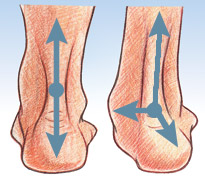My Achilles pain was getting better and then it flared up again recently and it has stayed flared for a while. This has been an ugly aggravation as it was a serious regression. Now, I’m very happy to report that my Achilles tendon irritation seems to be fading away. I’ve done three short-distance run/walks with no pain. (Will it stay gone is the real question.) What has helped?
Time off
Initially I thought that simply changing the way I ran would allow me to side-step whatever healing process that needed to take place. I revisited several technique changes that helped me overcome a past bout of Achilles pain. I discovered that there was no magic fix. Minding my technique is a good idea but it seems my tissues still needed time to heal.
Heel lift
I put a 1/4 inch heel lift in my shoe. The idea is to give a little bit of slack to the sore tendon.
To this point, I made sure not to do much in the way of stretching the tendon. It’s often a mistake to think that if it’s sore, it must need stretching. In fact, the damage to the Achilles may have been brought on by it’s being stretched too much and/or too fast.
Eccentric strength work
I’m continuing the work I wrote about in the last blog post. Runner’sConnect.net has a comprehensive guide to both Achilles pain rehab and prevention strategies. I won’t rehash it here.
Extensor hallucis brevis work
I think this has been a BIG ONE. I believe that part of my problem stems from my inability to adequately anchor to the ground the distal end of my first metatarsal, aka the ball of my big toe. How might that affect my Achilles tendon?
If I can’t secure that first met head to the ground then I have a weak foot tripod as the Gait Guys have described it.That means that my foot might pronate in an uncontrolled way which can result in something like the image to the right. Too much of that done too often and/or too fast could over-stress the Achilles causing damage and pain. To form a solid foot tripod, I need to be able to secure the center of my calcaneus (heel bone), first metatarsal head (ball of the big toe) and the fifth metatarsal head (ball of the little toe.)
(To be clear, I can’t say this is The Cause for anyone else’s Achilles problems. Someone else may be able to run with lots of pronation and feel fine.)
How did I know I had difficulty getting that met head to the ground? I’ve been videoed running and I could see this extended pronation occurring. I could feel it as I tried doing the exercise in the following video. This gets into what seems like some real minutiae. For me, it seems pretty important. Also, I don’t believe this movement is trained in the eccentric strength protocol I mentioned above.
Metronome running
I’ve read several discussions (here, here, here) on running cadence and loading rate as it pertains to injury risk. Essentially, by using a quicker cadence we should load the tissues of the foot for less time per foot fall thus resulting in less stress to those tissues. That’s exactly something I need.
I went back to using a metronome when I run so that I can make sure to keep a quick pace. I set the metronome from 170 to 180 bpm and matched my cadence to the beat. It’s definitely a quicker cadence than what I’m used to. Seems I’ve backslid some on minding my cadence. Going forward, I think it will be a good idea to periodically run with a metronome to ensure that I’m staying quick on my feet.

